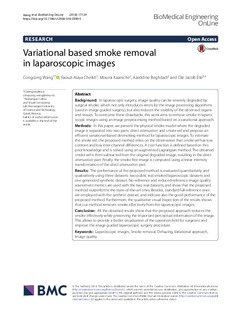| dc.contributor.author | Wang, Congcong | |
| dc.contributor.author | Alaya Cheikh, Faouzi | |
| dc.contributor.author | Kaaniche, Mounir | |
| dc.contributor.author | Beghdadi, Azeddine | |
| dc.contributor.author | Elle, Ole Jacob | |
| dc.date.accessioned | 2019-01-29T14:28:25Z | |
| dc.date.available | 2019-01-29T14:28:25Z | |
| dc.date.created | 2018-10-19T11:32:18Z | |
| dc.date.issued | 2018 | |
| dc.identifier.issn | 1475-925X | |
| dc.identifier.uri | http://hdl.handle.net/11250/2582906 | |
| dc.description.abstract | Background
In laparoscopic surgery, image quality can be severely degraded by surgical smoke, which not only introduces errors for the image processing algorithms (used in image guided surgery), but also reduces the visibility of the observed organs and tissues. To overcome these drawbacks, this work aims to remove smoke in laparoscopic images using an image preprocessing method based on a variational approach.
Methods
In this paper, we present the physical smoke model where the degraded image is separated into two parts: direct attenuation and smoke veil and propose an efficient variational-based desmoking method for laparoscopic images. To estimate the smoke veil, the proposed method relies on the observation that smoke veil has low contrast and low inter-channel differences. A cost function is defined based on this prior knowledge and is solved using an augmented Lagrangian method. The obtained smoke veil is then subtracted from the original degraded image, resulting in the direct attenuation part. Finally, the smoke free image is computed using a linear intensity transformation of the direct attenuation part.
Results
The performance of the proposed method is evaluated quantitatively and qualitatively using three datasets: two public real smoked laparoscopic datasets and one generated synthetic dataset. No-reference and reduced-reference image quality assessment metrics are used with the two real datasets, and show that the proposed method outperforms the state-of-the-art ones. Besides, standard full-reference ones are employed with the synthetic dataset, and indicate also the good performance of the proposed method. Furthermore, the qualitative visual inspection of the results shows that our method removes smoke effectively from the laparoscopic images.
Conclusion
All the obtained results show that the proposed approach reduces the smoke effectively while preserving the important perceptual information of the image. This allows to provide a better visualization of the operation field for surgeons and improve the image guided laparoscopic surgery procedure. | nb_NO |
| dc.language.iso | eng | nb_NO |
| dc.publisher | BMC (part of Springer Nature) | nb_NO |
| dc.rights | Navngivelse 4.0 Internasjonal | * |
| dc.rights.uri | http://creativecommons.org/licenses/by/4.0/deed.no | * |
| dc.title | Variational based smoke removal in laparoscopic images | nb_NO |
| dc.title.alternative | Variational based smoke removal in laparoscopic images | nb_NO |
| dc.type | Journal article | nb_NO |
| dc.type | Peer reviewed | nb_NO |
| dc.description.version | publishedVersion | nb_NO |
| dc.source.volume | 17 | nb_NO |
| dc.source.journal | Biomedical engineering online | nb_NO |
| dc.source.issue | 139 | nb_NO |
| dc.identifier.doi | 10.1186/s12938-018-0590-5 | |
| dc.identifier.cristin | 1621668 | |
| dc.description.localcode | © The Author(s) 2018. This article is distributed under the terms of the Creative Commons Attribution 4.0 International License (http://creativecommons.org/licenses/by/4.0/) | nb_NO |
| cristin.unitcode | 194,63,10,0 | |
| cristin.unitname | Institutt for datateknologi og informatikk | |
| cristin.ispublished | true | |
| cristin.fulltext | original | |
| cristin.qualitycode | 1 | |

